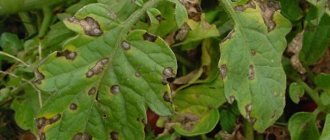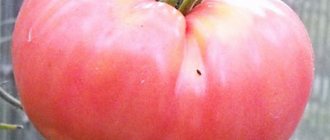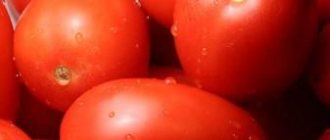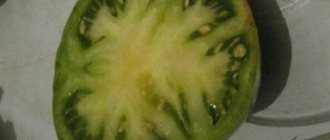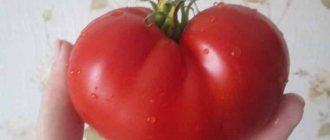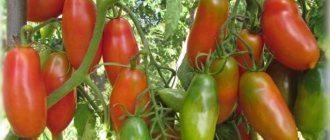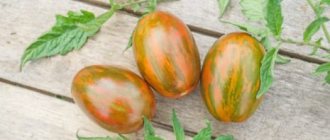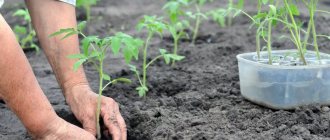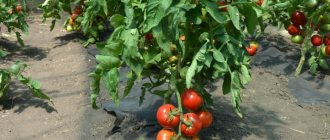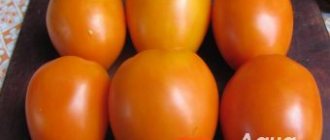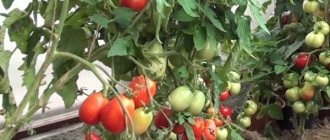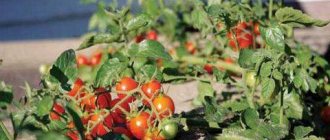Varietal characteristics
The Siberian early ripening variety is characterized by a determinant type of growth. The bushes are stocky, depending on the growing conditions, the height varies from 50 to 70 cm. During the growing season, 3-4 compact inflorescences are formed on the plant. In each inflorescence, under favorable conditions, up to 7 ovaries are formed.
Tomato fruits are medium-sized, smooth, round in shape, with an average weight of 100 grams. The tomato pulp is dense and has a rich tomato flavor. The average yield with good care is about 7 kg of tomatoes per m². Due to the high dry matter content, the fruits are well suited for processing into tomato products.
An early and productive “veteran”
Well-leafed tomato bushes grow up to half a meter, in a greenhouse they reach 70-80 cm. The determinate variety begins to bear fruit in 90-100 days, but the timing differs, as it depends on agricultural technology and the climate of the area. Color appears after 5-6 leaves, 5-7 fruits in the cluster.
Tomatoes are round, slightly flattened, with smooth and dense red skin. Some fruits have ribbing, but this does not spoil their appearance. Weight – from 70 to 110 grams, the fruits are even. Siberian early ripening has a taste characteristic of early tomatoes - sweet-sour, pleasant. There is an aroma, and gardeners note that it is precisely because of this aroma and taste that they prefer the Siberian variety.
Seeds from various manufacturers are available for sale:
- Aelita;
- Plasma Seeds;
- Siberian Garden;
- SeDek.
Summer residents value early-ripening tomatoes for their versatility in using fruits. They are tasty fresh, suitable for lecho, pickling, and canning. In preparations, whole fruits retain their shape and do not crack.
Tomatoes are perfectly preserved for up to a month and do not lose their presentation and taste during transportation.
Advantages and disadvantages of the variety
Like any other tomato, Siberian early ripening has its advantages and disadvantages. Among the advantages it should be noted:
- high productivity;
- early, friendly maturation;
- high disease resistance;
- resistance to temperature changes.
According to reviews from vegetable growers, the Siberian early ripening tomato has no significant drawbacks. The only thing worth noting is the mediocre taste of the fruit.
Description
All the main characteristics of the variety that you need to know before planting:
- The variety is early ripening, the fruits ripen all together.
- From one square meter you will get from 6 to 9 kg of tomatoes, that is, the yield is high.
- There are usually from 3 to 5 fruits on the cluster.
- One fruit weighs from 60 to 100 grams.
- The shape is round, almost not ribbed.
- Color – deep red.
- The skin is dense, so it will not crack during transportation and cooking.
- They are stored for a long time and easily survive transportation.
- Resistant to many diseases.
- The fruits can ripen on their own if they are placed in a warm and bright place.
- The variety is resistant to temperature changes; it can be grown even in very cold soil, but then the fruits will not all be the same size, although they will retain their taste.
The variety can also be called unpretentious, which means that even a beginner can handle it. You can appreciate the simplicity of the process by studying the detailed planting and care diagram proposed below.
Siberian can be called one of the unique varieties of tomatoes, since it is least often grown in those Russian regions where the climate is warm. Siberian early ripening feels better where it is cooler, that is, in the western, northern and eastern parts of Russia.
Sowing technique
Tomato is cultivated through seedlings. Sowing of seeds begins 50-60 days before the expected date of planting in the ground. For most Russian regions, these are the last days of March.
Advice! To speed up and improve germination, seeds can be soaked in a solution of growth stimulants before sowing. For example, you can use the well-known “Epin”.
The seeds, swollen after soaking, are sown to a depth of 0.5 cm. A loose, nutritious soil mixture is used as seed soil. It is made up of equal parts:
- turf land,
- humus,
- clean river sand.
To sow tomatoes, you can use a ready-made universal peat-based substrate for growing seedlings.
Harvest and storage
The fruits ripen on the bushes at the same time.
The Siberian early ripening tomato variety is characterized by friendly, almost simultaneous ripening of the fruits. Harvesting can be done as quickly as possible. The fruits are removed from the bush in a state of technical ripeness, when the outer shell has not yet acquired the characteristic red color.
Vegetables can reach full maturity on a windowsill or other well-lit place.
The fruits of this variety are not suitable for long-term storage. In a short time, despite the dense and elastic peel, their taste and presentation deteriorate significantly. They recommend finding a use for them as quickly as possible.
Growing seedlings - fertilizing, picking
After the emergence of seedlings, the seed container is placed in a well-lit place with a temperature of +20-22°. Seedlings are watered as the substrate dries. After 10 days from the emergence of seedlings, the seedlings are fed with nitrogen fertilizer. For example, you can use urea.
As soon as the seedlings develop 2 true leaves, begin picking. To do this, prepare separate cups with a volume of about half a liter. Before picking, water the seedlings well. Before planting in a cup, pinch the central root of each seedling.
Further care of tomato seedlings consists of timely watering and periodic application of fertilizers. For fertilizing, complex compositions for growing seedlings are used.
As soon as the average daily temperature reaches +15°, the plants are planted in the ground. 2 weeks before planting, the seedlings begin to harden - they are taken out to a cool balcony, veranda or outside on warm days for a day. You should not immediately expose tomatoes to the sun for a long time.
Reviews from those who planted
Alexander Petrovich, 51 years old, Yekaterinburg: “I was skeptical about the variety, it’s very old. I didn’t expect any special results in terms of early maturity or yield. The seedlings of the Siberian early ripening pleased me. It was the first to form buds. I picked the first red tomatoes after 80 days. The fruits are very cute and taste better than store-bought ones. There are a lot of stepchildren, I had to remove them regularly. The variety set fruit well and a lot.”
Irina Grigorievna, 30 years old, Kemerovo: “I’m a beginner gardener. I grew the Siberian early ripening tomato in the garden and in the greenhouse. The summer was cold. The first tomatoes turned red only in August, so my variety was not early. I sown the seedlings not too late, in the last ten days of March.”
Yulia Sergeevna, 43 years old, Perm: “I grew Siberian early ripening for one season in open ground and in a greenhouse. I didn't like the variety. The tomatoes didn't ripen for a long time. Their taste is fresh. Ripening time is the same as for mid-season tomatoes. Ground-grown tomatoes were tastier than greenhouse tomatoes.”
Landing on the street
To plant tomatoes, you need to choose an open, sunny place. Even slight shading will significantly reduce the yield. Light, quickly warming soils are best suited for growing tomatoes. On clay soils with close groundwater, the crop suffers from late blight.
Attention! Tomato plantings should not be placed after peppers, eggplants, and potatoes. These crops share common diseases and pests that remain in the soil.
Seedlings of this tomato are planted at the rate of 3-4 plants per square meter. The optimal distance between rows is 40-50 cm. Dense planting impairs ventilation, resulting in an increased risk of developing fungal diseases. Before planting, mineral fertilizers and humus are added to the soil.
Immediately after planting, the plants are watered abundantly, then covered with non-woven covering material, which protects the seedlings from sunburn and significantly speeds up the adaptation process. As soon as the tomatoes begin to grow, the cover is removed.
Siberian early ripening tomatoes on video
If you grew Siberian early ripening tomatoes, write whether you liked them or not. What was the yield and taste of the fruits like under your climatic conditions? How do you assess the resistance of this variety to diseases and pests? If possible, attach to the comment a photo of the entire bush as a whole or individual fruits that you grew. Thank you!
Your reviews of the Siberian early ripening tomato and additions to the description will help many gardeners evaluate this variety and decide whether it is worth planting or not.
Care
Tomato care includes:
- timely watering,
- loosening the soil,
- applying fertilizers.
Mulching
It is recommended to mulch the soil under the bushes with a layer of last year’s sawdust and leaves. Water the mulch on top with a urea solution. This technique allows you to reduce the number of watering, loosening and weeding. The mulch layer promotes a more uniform distribution of heat and nutrients.
Feeding
During the period of intensive growth of vegetative mass, the first fertilizing is carried out. Use a fermented solution of mullein or chicken manure. In the absence of organic matter, urea is used.
2 weeks after the first feeding, phosphorus-potassium fertilizers are applied, for example, potassium monophosphate. On average, 0.5 liters of the prepared solution is poured under each bush.
Attention! When choosing fertilizers for tomatoes, you should avoid chlorine-containing mixtures.
In the absence of phosphorus-potassium fertilizers, you can use ordinary wood ash. It is diluted at the rate of 1 glass per 10 liters of water.
Caring for tomatoes after transplantation
Proper care will help keep plants healthy
Thanks to proper crop care, you can achieve the highest possible fruit yield. The plants will have good immunity and will be less at risk of developing diseases typical of tomatoes.
Watering
It is recommended to water tomatoes regularly and moderately (1-2 times a week, 1 liter for each bush). It is better to do this in the evening or morning, when there is no solar activity. Water for this purpose must be used warm and settled.
From time to time you can add a small amount of potassium permanganate (potassium permanganate) to it. This is done as a disease prevention measure.
It is important to remember that watering should be moderate: an excess of moisture in the soil can provoke the occurrence of putrefactive diseases.
Feeding and loosening
During the entire growing season, it is recommended to fertilize tomatoes 3-4 times. It is advisable to use liquid fertilizers for this purpose: this will allow them to penetrate the soil evenly. Complex additives, mullein infusion, and nitrophoska are used as top dressing.
Regular loosening of the soil will not only get rid of weeds, but will also help retain moisture in the ground for a longer time. Due to the “fluffing” of the soil, oxygen access to the plant’s root system increases.
():
Loosening the soil destroys the intrasoil capillaries, through which moisture from the lower layers was drawn to the surface and evaporated from the soil. In addition, after loosening, an “earth mulch” is created on the surface, which also protects the roots from overheating.
Stepping and bush formation
The Siberian early-ripening variety is low-growing, but its strong foliage suggests pinching. To do this, excess foliage and additional shoots are regularly plucked off. They do not create ovaries, they only extract useful substances from the crop.
When growing in greenhouses, it is recommended to tie tomato bushes to vertical supports. This will save space and simplify crop care.
It is better to form a tomato bush with no more than 3 stems. This will allow the plant to produce the maximum number of medium-sized fruits. The description of the variety indicates that an adult bush should have no more than 8 flower clusters.
Disease and pest control
A characteristic feature of the Siberian early ripening variety is its increased resistance to diseases such as tobacco mosaic and brown spot. The plant is often subject to root rot and late blight.
The occurrence of these diseases often occurs due to improper care of the vegetable (excess moisture in the soil, ignoring preventive treatments of the crop).
To prevent diseases, it is recommended to spray tomatoes with special fungicidal and triazole preparations (Bravo, Ditan, HOM). Use them according to the instructions.
Available means include solutions of potassium permanganate and hydrogen peroxide. They regularly treat the external parts of the crop and the soil underneath it.
If a diseased plant is identified in an area, it is recommended to immediately get rid of it by removing it from the garden bed and destroying it away from it. It is better to immediately subject the remaining specimens to preventive treatment (spraying and watering the soil) with special means intended for this purpose.
Among the pests of tomatoes are wireworms, mole crickets, aphids, nematodes, etc. They are controlled with the help of insecticides. Traditional methods in this case are ineffective.
Possible growing problems
Under normal conditions, tomato plants self-pollinate well. But in the summer heat, the pollen becomes stickier. In such cases, to improve pollination, it is recommended to shake the tomato bushes slightly. This will help significantly improve fruit set.
In cool, rainy summers, the risk of developing late blight increases sharply. The spread of the disease begins from the lower tier of leaves. Poor ventilation and high humidity levels contribute to the development of the disease. To stop the further spread of late blight, plants are treated with a solution of copper-containing fungicide. For example, you can use Bordeaux mixture. After 10 days, the treatment must be repeated.
The best varieties for open ground - 10 varieties
In open ground conditions, the most disease- and weather-resistant tomato varieties are grown. Here are the best of them, according to reviews from gardeners.
Variety Siberian Troika
Mid-season determinate tomato, ripening in 110-115 days. The plant is 60 centimeters high.
The fruits are cylindrical or pepper-shaped with a small spout; 5-10 pieces are formed in the cluster. The peel is dense but tender. The color is bright red. The pulp is sweet, tasty, juicy, with 3-4 chambers. Length – 15 centimeters. Weight – 200-350 grams. The fruits are used in salads and various preparations.
The yield of one plant is 5 kilograms of fruit, per square meter - 15-20 kilograms.
Review:
Valentina Tikhomirova
We don’t have a greenhouse, so every year we grow tomatoes in open beds. The Siberian Troika variety is perfect for this. You don’t have to wait long for the harvest; the tomatoes taste excellent. From each bush we remove at least 5 kg per season. This amount of vegetables is enough for salads and pickling.
The most productive Siberian tomato varieties - Troika and Sibirskaya Troika: video
Hybrid variety Siberian Trump
Mid-season determinate tomato, bearing fruit on the 110th day after germination. The plant is 80 centimeters high.
The fruits are flattened-round, slightly ribbed, 5-15 pieces grow in a cluster. The peel is dense. The color is crimson-red. The pulp is fleshy, dense and very juicy. Weight – 300-700 grams. The purpose of tomatoes is salad.
The yield of one tomato bush is 5-7.5 kilograms.
Review:
Dmitriy
I have been growing tomatoes for many years and have come to the following conclusion: varieties must be chosen based not only on taste preferences, but also taking into account the climate. I planted different tomatoes, with varying degrees of success, but “Siberian Trump” only made me happy. And friendly germination, and a bountiful harvest, despite the cold and rainy summer.
Variety King of Giants
Mid-season indeterminate tomato, ripening 110-120 days after the appearance of the first shoots. The plant reaches 1.5-2 meters in height.
The fruits are flattened and round. The peel is dense. The color is bright red with a green spot at the stalk. The pulp is juicy, fleshy, sour-sweet, consists of 7-8 chambers. Weight – 450-1000 grams. The fruits are used fresh and for making ketchups, juices, purees, adjika and other preparations.
The yield reaches 7-8 kilograms of fruit from one bush.
Review:
Svetlana
I planted this variety for the first time this year. I can say that I was really pleased with the harvest. I collected about 5-6 kg per bush. I planted tomatoes in open ground. And although the weather this year was not so great (there was a lot of rain), our family still had enough for salads, and so, to eat the whole thing, we made 12 cans of tomato juice. I didn’t have time to wrap them whole in jars - I ran out of tomatoes. Next year I will plant more.
Ultra early ripening variety
An early ripening determinate tomato that produces a harvest in 70-75 days. The plant is 90 centimeters high.
The fruits are oval, 6-8 pieces grow on the cluster. The peel is dense, glossy. The color is bright red. The pulp is sweetish and juicy. Weight – 100-120 grams. Tomatoes have a universal purpose.
The yield per square meter is 15 kilograms of fruit.
Review:
Nikolay Veselov
I planted the Ultra early ripening tomato in open ground and didn’t bother with greenhouses. The harvest ripened earlier than other early varieties. Tomatoes look beautiful and taste great. The harvest was good, we even managed to make a few jars. I will plant the Ultra Early ripening variety in the following seasons.
Variety Velmozha
Mid-early determinate tomato, ripening from the moment of germination, after 100-110 days. The height of the plant does not exceed 70 centimeters.
The fruits are elongated, heart-shaped. The peel is tender and thin. The color is light pink or dark red. The pulp is tasty, sweet, aromatic, fleshy, dense, tender, consisting of 5-9 chambers. Weight – 300-1500 grams. The purpose of the fruit is salad.
The yield of one meter is 5-7 kilograms of vegetables.
Review:
Natalia Tikhonenko
I really like the “Velmozha” variety. Its tomatoes are especially sugary and aromatic. The harvest ripens in full before the arrival of cold weather and late blight. There are no difficulties in growing such tomatoes. I advise everyone who has not yet tried Velmozha tomatoes to grow this variety.
Variety Demidov
Mid-early determinate tomato, ripening in 100-110 days, counting from the day of sowing. The plant is 65 centimeters high.
The fruits are round, with medium ribbing. The peel is dense. The color is pink. The pulp is fleshy, sweet, consists of 4 chambers. Weight – up to 130 grams. Fruits for universal table use.
The yield per square meter is 11-17 kilograms.
Review:
Mikhail Komarov
My wife became interested in this variety. I planted the seedlings, and they sprouted without problems. Very pleased. The tomatoes are fleshy and sweet. No excess water or acid. This is now our favorite variety!
Alsou variety
Mid-early determinate tomato, producing first fruits in 105-110 days. The plant grows in height up to 80-120 centimeters.
The fruits are pepper-shaped, slightly ribbed. The peel is medium density, glossy. The color is bright red with a dark green spot near the stalk. The pulp is juicy, tasty, multi-chambered. Weight – 300-800 grams. The fruits are used to prepare salads, juices, ketchups, adjika, pasta, lecho.
The yield of one meter of planting is 7-9 kilograms of fruit.
Review:
Galina Ivanovna Mezentseva
The variety is liked for its early ripening and excellent yield. The fruits are large and sweet. The seedlings are weak, with thin tops. But in open ground, the tomato shows itself in all its glory - the bush stretches up to 1 m, is productive and large-fruited. We received ripe tomatoes on June 28 when sowing seedlings on February 27. We don’t have time to roll them up - we eat the entire harvest in salads. Alsou always helps me out if other varieties of tomatoes have failed.
Variety Golden Domes
Mid-season determinate tomato, with a growing season of 110-117 days. The plant is 0.9-1.5 meters high.
The fruits are dome-shaped. The peel is glossy. The color is yellowish-orange. The pulp is sugary, sweet, four-chambered. Weight – 300-800 grams. The fruits are used in salads, adjika, ketchup, juices, and purees.
Productivity – 10-13 kilograms per 1 square meter.
Review:
Basil
“I planted tomatoes in open ground, to be honest, I didn’t expect any special results in our climate. However, I was pleased with the harvest, and the fruits themselves are large, sweet and good in salads.”
Variety King of Siberia
Mid-season indeterminate tomato, ripening in 110-117 days. The plant is 1.6-1.8 meters high.
The fruits are heart-shaped, 3-5 pieces grow on a cluster. The peel is glossy. The color is yellow-orange. The pulp is juicy, fleshy, tasty. Weight – 300-1000 grams. One bush produces 5.5 kilograms of fruit, one meter of beds produces 15-17 kilograms.
Review:
Mikhail Nikiforovich
I would like to express my deep gratitude to the breeders for this wonderful vegetable. The fact is that since childhood I have been allergic to all red vegetables. Naturally, eating red tomatoes is contraindicated for me. Orange tomatoes King of Siberia have become a real salvation for me. For the first time, my relative from Novosibirsk sent me the seeds of this variety of tomatoes. Now I grow them in my garden every year. King of Siberia tomatoes have an excellent taste, I collect high yields from each bush, I really like everything.
Variety Monastic meal
Mid-season determinate tomato, ripening from the moment of sowing the seeds in 120-130 days. Plant up to 1 meter high.
The fruits are round and even. The peel is smooth and dense. The color is bright orange. The pulp is tender, tasty, sweet. Weight – 150-400 grams. Universal use.
Review:
Zoya
“Monastic Meal” is my favorite variety, the fruits are medium-sized, elastic, the flesh is tender, there is no acid, it’s perfect for salad, I’ve never used it in a capper. I make seedlings myself, as best I can, there were no problems with them, in the garden the bush grows up to a meter, its stem is powerful, but nevertheless it requires staking. The variety is mid-early and one of the first to bear fruit.
